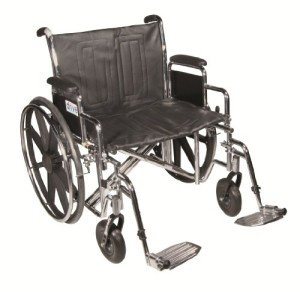20 Reasons To Believe Bariatric Wheelchair 24 Inch Seat Cannot Be Forgotten

Bariatric Wheelchair Seat Width
Seat Width
Having the correct seat width is very important to wheelchair users who spend longer periods in their chairs. Too narrow a seat will trigger pressure on the hips and thighs which could result in sores or pressure points. Having too large a seat can also make it challenging for the user to reach the hand rims to move themselves or maneuver in little areas.
To determine the appropriate seat width an individual would rest on a chair usually and have their measurement taken across their lap at the largest point which is generally their hips. A wheelchair measuring tape can be used to determine this, but a backyard stick is preferred as it avoids individuals from covering the tape around their hips which would provide an inaccurate result.
The basic wheelchair seat width is 16" (narrow adult), 18" (basic grownup), and 20" (broad grownup). For click through the up coming web page , a 24" seat is offered. This durable additional wide bariatric wheelchair from Medline features swing-away footrests, a carbon steel frame with rust- and chip-resistant chrome plating, and easy-to-clean vinyl upholstery. It has a weight capacity of 500 pounds.
Seat Depth
Generally, the seat depth of a bariatric wheelchair was added 2" to the measurement taken at the user's best point (generally their hips). This was indicated to accommodate extra layers of clothing that may be worn during winter. Nevertheless, this practice is becoming less typical as wheelchair users are able to spend more time inside your home and are not wearing long coats. This makes the seat depth of a chair lesser when choosing a bariatric wheelchair. However, it is still crucial to choose a choice that offers sufficient assistance for larger users.
The Medline folding additional broad bariatric manual wheelchair features a comfy 24" seat width and a durable slide tube silver vein frame. It also has an adjustable axle and tool-free raising legrests.
Seat Height

When it pertains to determining the proper wheelchair seat width you ought to always determine from the user's widest point which is usually their hips. You will also require to consider whether the user is going to be wearing a winter season coat as this might add 2" to the width required.
When a wheelchair remains in use it need to just be operated on level surface areas with the wheel locks fully engaged. This is to avoid the chair from being able to move slopes that are 10 degrees or higher. It is likewise important to remember that any activity that may shift the center of mass in the chair should be done with care. This consists of grabbing items that require the person to lean out of their seat or attempting to stand up from it.
Whenever you have the chair in usage it is recommended that you regularly inspect it for damage and oil any locations that are deemed required. For instance, the casters must be lubricated by removing the caster fork and using a multi-purpose grease to apply to the caster stem bearings. Likewise, the foot plates can be changed by loosening up the bolt and after that moving them to the preferred position. This enables the feet to sit conveniently on the footplate and avoids any pressure points from forming. This can be very uneasy for the user and if left unattended, can result in pressure sores.
Weight Capacity
Bariatric wheelchairs are developed to support more weight than basic wheelchairs. This makes them tougher and much better equipped to handle falls. They are likewise typically larger and wider, making them less maneuverable in tight areas than standard wheelchairs. They require lorries with special ramps and lifts to load them, as well as chauffeurs who know how to best transport them from one area to the next.
When picking a wheelchair, consider its weight capacity as it will be the main determining element in whether it will accommodate your traveler's requirements. The weight capacity of the chair is frequently listed as a static load, meaning that it shows the quantity of weight the chair can easily hold while stalling. Nevertheless, some manufacturers likewise list an active load that is based upon a drop test and can replicate the impact of someone taking a seat in the chair. This might be a more reliable measurement of the weight limit, depending on your needs.
If you plan to perform activities that shift your center of gravity in the seat (such as reaching for items), be sure to have front casters pointed in a forward instructions and wheel locks engaged so the chair will not tip over. Likewise, inspect that bariatric wheelchair 26 inch seat are oiled regularly to avoid extreme wear and abrasions. listen to this podcast includes getting rid of the fork, separating the caster from the wheel, and greasing the caster stem bearings with premium multi-purpose grease.
